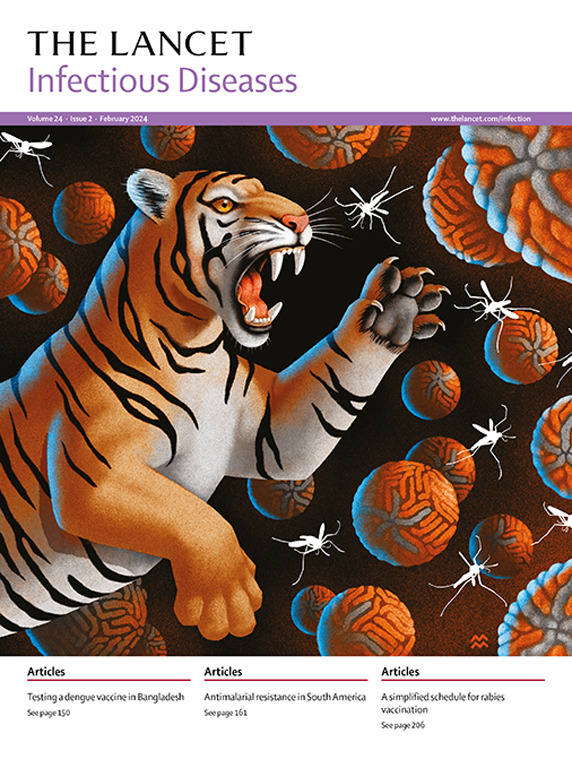Mycoplasma pneumoniae infection in adult inpatients during the 2023–24 outbreak in France (MYCADO): a national, retrospective, observational study
IF 36.4
1区 医学
Q1 INFECTIOUS DISEASES
引用次数: 0
Abstract
Background
An epidemic of Mycoplasma pneumoniae infection has been observed in France since September, 2023. We aimed to describe the characteristics of adults hospitalised for M pneumoniae infection and identify factors associated with severe outcomes of infection.Methods
MYCADO is a retrospective observational study including adults hospitalised for 24 h or more in 76 hospitals in France for a M pneumoniae infection between Sept 1, 2023, and Feb 29, 2024. Clinical, laboratory, and imaging data were collected from medical records. We identified factors associated with severe outcomes of infection, defined as a composite of intensive care unit (ICU) admission or in-hospital death, using multivariable logistic regression.Findings
1309 patients with M pneumoniae infection were included: 718 (54·9%) were men and 591 (45·1%) were women; median age was 43 years (IQR 31–63); 288 (22·0%) had chronic respiratory failure; 423 (32·3%) had cardiovascular comorbidities; and 105 (8·0%) had immunosuppression. The most common symptoms were cough (1098 [83·9%]), fever (1023 [78·2%]), dyspnoea (948 [72·4%]), fatigue (550 [42·0%]), expectorations (473 [36·1%]), headache (211 [16·1%]), arthromyalgia (253 [19·3%]), ear, nose, and throat symptoms (202 [15·4%]), diarrhoea (138 [10·5%]), and vomiting (132 [10·1%]). 156 (11·9%) of 1309 patients had extra-respiratory manifestations, including 36 (2·8%) with erythema multiforme, 19 (1·5%) with meningoencephalitis, 44 (3·4%) with autoimmune haemolytic anaemia, and 17 (1·3%) with myocarditis. The median hospital stay was 8 days (IQR 6–11). 424 (32·4%) patients had a severe outcome of infection, including 415 (31·7%) who were admitted to the ICU and 28 (2·1%) who died in hospital. Those more likely to present with severe outcomes of infection were patients with hypertension, obesity, chronic liver failure, extra-respiratory manifestations, pulmonary alveolar consolidation or bilateral involvement on CT scan, as well as elevated inflammatory markers, lymphopenia or neutrophilic polynucleosis, and those who did not versus did receive any antibiotic active against M pneumoniae before admission.Interpretation
This national, observational study highlighted unexpected, atypical radiological presentations, a high proportion of transfers to the ICU, and an association between severity and delayed administration of effective antibiotics. This should remind clinicians that no radiological presentation can rule out M pneumoniae infection, and encourage them to reassess patients early after prescribing a β-lactam, or even to discuss prescribing macrolides as first-line treatment in the context of an epidemic.Funding
None.Translation
For the French translation of the abstract see Supplementary Materials section.求助全文
约1分钟内获得全文
求助全文
来源期刊

Lancet Infectious Diseases
医学-传染病学
CiteScore
60.90
自引率
0.70%
发文量
1064
审稿时长
6-12 weeks
期刊介绍:
The Lancet Infectious Diseases was launched in August, 2001, and is a lively monthly journal of original research, review, opinion, and news covering international issues relevant to clinical infectious diseases specialists worldwide.The infectious diseases journal aims to be a world-leading publication, featuring original research that advocates change or sheds light on clinical practices related to infectious diseases. The journal prioritizes articles with the potential to impact clinical practice or influence perspectives. Content covers a wide range of topics, including anti-infective therapy and immunization, bacterial, viral, fungal, and parasitic infections, emerging infectious diseases, HIV/AIDS, malaria, tuberculosis, mycobacterial infections, infection control, infectious diseases epidemiology, neglected tropical diseases, and travel medicine. Informative reviews on any subject linked to infectious diseases and human health are also welcomed.
 求助内容:
求助内容: 应助结果提醒方式:
应助结果提醒方式:


